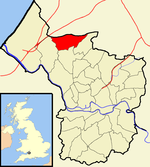Hallen Halt railway station
Disused railway stations in Bristol, Bath and South GloucestershireFormer Great Western Railway stationsPages with no open date in Infobox stationRailway stations in Great Britain closed in 1915Railway stations in Great Britain closed in 1918 ... and 4 more
Railway stations in Great Britain opened in 1910Railway stations in Great Britain opened in 1917South West England railway station stubsUse British English from January 2018
Hallen Halt railway station was a railway station in Hallen, Gloucestershire, England, on the Henbury Loop Line. The station is closed, and the line is closed to passengers.
Excerpt from the Wikipedia article Hallen Halt railway station (License: CC BY-SA 3.0, Authors).Hallen Halt railway station
Hallen Road,
Geographical coordinates (GPS) Address External links Nearby Places Show on map
Geographical coordinates (GPS)
| Latitude | Longitude |
|---|---|
| N 51.5122 ° | E -2.6415 ° |
Address
Hallen Halt
Hallen Road
BS10 7RP , Almondsbury
England, United Kingdom
Open on Google Maps








